Fatigue Properties and Damage Characteristics of Polyurethane Mixtures under a Stress Control Mode
Abstract
:1. Introduction
2. Materials and Methods
2.1. Materials
2.2. Mixture Composition Design
3. Methodology
3.1. Experimental Scheme
3.1.1. Preparation of the Test Specimens and Preservation
- (1)
- The PUM-10 and PUM-13 were prepared at room temperature, and the SMA-10 was mixed in accordance with the “Standard Test Methods of Bitumen and Bituminous Mixtures for Highway Engineering”.
- (2)
- The evenly mixed mixture was loaded into a 500 mm × 500 mm × 70 mm test mold, and the test specimens were formed using the wheel grinding method.
- (3)
- After curing at 15 °C for 4 days, the mold was removed, and the core was cut from the specimen. The size of the specimens was 380 mm × 65 mm × 50 mm, which were maintained at room temperature for 1 day.
- (4)
- White matte primer was sprayed on the surface of the test specimens, followed by a matte black speckle; the finished specimens are shown in Figure 1.
3.1.2. Ultimate Bending Static Test
3.1.3. Four-Point Bending Fatigue Test
- (1)
- Load waveform
- (2)
- Load level
- (3)
- Fatigue load cycle eigenvalues
- (4)
- Loading process and method
3.1.4. The DSCM Test
3.2. Calculation Method
3.2.1. Calculation Method of a Simply Supported Beam with Equal Moments
3.2.2. Fatigue Damage Definition Based on Stiffness
4. Results and Discussion
4.1. Static Load Failure Characteristics
4.2. Fatigue Characteristics of PUM
4.2.1. Fatigue Life Analysis of PUM
4.2.2. Variation Trends of Stiffness
4.2.3. Development Law of the Mid-Span Deflection
4.3. Analysis of the Maximum Tensile Strain Based on DSCM Data Acquisition
4.4. Fatigue Damage Characteristics of PUM
4.4.1. Development Law of Fatigue Damage Based on Stiffness
4.4.2. Fatigue Damage Function Construction Based on Stiffness Degradation
5. Conclusions
- (1)
- The bending failure processes of PUM and SMA differ under static loading, and the curves of PUM only go through an elastic stage and stress relaxation stage. The static failure mode and fatigue damage of PUM is brittle failure.
- (2)
- The fatigue life of PUM is much larger than that of SMA under the same bending stress. The fatigue damage of PUM exhibits an obvious three-stage damage law and the fatigue damage leads to brittle failure.
- (3)
- The deflection development and maximum strain development increment of PUM increase significantly at the beginning of the fatigue cycle. With increases in the fatigue load cycles, the growth rate slows down and enters a relatively stable development stage, and increases greatly near failure.
- (4)
- The calculation method of the fatigue damage factor based on stiffness degradation is constructed, and the fatigue damage functions of PUM at different load levels are fitted, which can help to predict the stiffness degradation of PUM.
- (5)
- In this paper, four-point bending tests with three load levels are carried out. It is necessary to carry out four-point bending fatigue tests with more load levels, so as to fit the S-N curve of PUM according to the fatigue life and applied stress amplitude. This can help predict the fatigue life of PUM.
Author Contributions
Funding
Conflicts of Interest
References
- Chem, Y.C.; Tseng, S.M.; Hsieh, K.H. Damping properties of interpenetrating polymer networks of polyurethane-modified epoxy and polyurethanes. J. Appl. Polym. Sci. 2015, 74, 328–335. [Google Scholar]
- Wang, Q.; Chen, S.; Wang, T.; Zhang, X. Damping, thermal, and mechanical properties of polyurethane based on poly (tetramethylene glycol)/epoxy interpenetrating polymer networks: Effects of composition and isocyanate index. Appl. Phys. A 2011, 104, 375–382. [Google Scholar] [CrossRef]
- Wang, J.; Yuan, J.; Xiao, F.; Li, Z.; Wang, J.; Xu, Z. Performance investigation and sustainability evaluation of multiple-polymer asphalt mixtures in airfield pavement. J. Clean. Prod. 2018, 189, 67–77. [Google Scholar]
- Chen, J.; Yin, X.; Wang, H.; Ding, Y. Evaluation of durability functional performance of porous polyurethane mixture in porous pavement. J. Clean. Prod. 2018, 188, 12–19. [Google Scholar]
- Chen, J.; Ma, X.; Wang, H.; Xie, P.; Huang, W. Experimental study on anti-icing and deicing performance of polyurethane concrete as road surface layer. Constr. Build. Mater. 2018, 161, 598–605. [Google Scholar] [CrossRef]
- Chen, J.; Yao, C.; Wang, H.; Huang, W.; Ma, X.; Qian, J. Interface Shear Performance between Porous Polyurethane Mixture and Asphalt Sublayer. Appl. Sci. 2018, 8, 623. [Google Scholar] [CrossRef]
- Wang, D.; Schacht, A.; Leng, Z.; Leng, C.; Kollmann, J.; Oeser, M. Effects of Materials Composition on Mechanical and Acoustic Performance of Poroelastic Road Surface (PERS). Constr. Build. Mater. 2017, 135, 352–360. [Google Scholar] [CrossRef]
- Wang, D.; Liu, P.; Leng, Z.; Leng, C.; Lu, G.; Buch, M.; Oeser, M. Suitability of Poroelatic Road Surface (PERS) for Urban Roads in Cold Regions: Mechanical Functional Performance Assessment. J. Clean. Prod. 2017, 165, 1340–1350. [Google Scholar] [CrossRef]
- Sun, M.; Bi, Y.; Zheng, M.; Wang, J.; Wang, L. Performance of polyurethane mixtures with skeleton-interlocking structure. J. Mater. Civ. Eng. 2020, 32, 04019358. [Google Scholar] [CrossRef]
- Lu, G.; Renken, L.; Li, T.; Wang, D.; Li, H.; Oeser, M. Experimental study on the polyurethane-bound pervious mixtures in the application of permeable pavement. Constr. Build. Mater. 2019, 202, 838–850. [Google Scholar] [CrossRef]
- Li, T.; Lu, G.; Wang, D.; Hong, B.; Tan, Y.; Oeser, M. Key Properties of High-performance Polyurethane Bounded Pervious Mixture. China J. Highw. Transp. 2019, 32, 158–169. (In Chinese) [Google Scholar]
- Lu, G.; Liu, P.; Wang, Y.; Faßbender, S.; Wang, D.; Oeser, M. Development of a sustainable pervious pavement material using recycled ceramic aggregate bio-based polyurethane binder. J. Clean. Prod. 2019, 220, 1052–1060. [Google Scholar] [CrossRef]
- Törzs, T.; Lu, G.; Monteiro, A.O.; Wang, D.; Grabe, J.; Oeser, M. Hydraulic properties of polyurethane-bound permeable pavement materials considering unsaturated flow. Constr. Build. Mater. 2019, 212, 422–430. [Google Scholar] [CrossRef]
- Lu, G.; Liu, P.; Törzs, T.; Wang, D.; Oeser, M.; Grabe, J. Numerical analysis for the influence of saturation on the base course of permeable pavement with a novel polyurethane binder. Constr. Build. Mater. 2020, 240, 1–9. [Google Scholar] [CrossRef]
- Xu, S.; Zhang, Y.; Guo, Y.; Ma, C.; Gao, D.; Peng, G. Determination of polyurethane concrete compaction timing based on penetration resistance test system. China J. Highw. Transp. 2021, 34, 226–235. (In Chinese) [Google Scholar]
- Sun, M.; Bi, Y.; Zhuang, W.; Chen, S.; Zhao, P.; Pang, D.; Zhang, W. Mechanism of polyurethane binder curing reaction and evaluation of polyurethane mixture properties. Coatings 2021, 11, 1454. [Google Scholar] [CrossRef]
- Cong, L.; Wang, T.; Tan, L.; Yuan, J.; Shi, J. Laboratory evaluation on performance of porous polyurethane mixtures and OGFC. Constr. Build. Mater. 2018, 169, 436–442. [Google Scholar] [CrossRef]
- Izaks, R.; Rathore, M.; Haritonovs, V.; Zaumanis, M. Performance properties of high modulus asphalt concrete containing high reclaimed asphalt content and polymer modified binder. Int. J. Pavement Eng. 2022, 23, 2255–2264. [Google Scholar] [CrossRef]
- Yoshida, N. Fatigue failure criterion for hydraulic graded iron and steel slag base-course and ITS implementation into the Japanese asphalt pavement design method. Struct. Eng. 2014, 2, 62–68. [Google Scholar] [CrossRef]
- Lv, S.; Luo, Z.; Xie, J. Fatigue performance of aging asphalt mixtures. Polimery 2015, 60, 126–131. [Google Scholar] [CrossRef]
- Lv, S.; Liu, C.; Yao, H.; Zheng, J. Comparisons of synchronous measurement methods on various moduli of asphalt mixtures. Constr. Build. Mater. 2018, 158, 1035–1045. [Google Scholar] [CrossRef]
- Maalej, M.; Quek, S.T.; Zhang, J. Behavior of Hybrid-Fiber Engineered Cementitious Composites Subjected to Dynamic Tensile Loading and Project Impact. J. Mater. Civ. Eng. ASCE 2005, 17, 143–152. [Google Scholar] [CrossRef]
- Zhang, J.; Gong, C.; Guo, Z.; Zhang, M. Engineered Cementitious Composites with Characteristic of Low Drying Shrinkage. Cem. Concr. Res. 2009, 39, 303–312. [Google Scholar] [CrossRef]
- Guo, Z.; Wang, L.; Feng, L.; Guo, Y. Research on fatigue performance of composite crumb rubber modified asphalt mixture under freeze thaw cycles. Constr. Build. Mater. 2022, 323, 126603. [Google Scholar]
- Shen, A.; Yu, M.; Zhou, X.; Lv, Z.; Song, P. Fatigue Damage and Full-cycle life estimation of rubber asphalt mixture. J. Build. Mater. Struct. 2018, 21, 620–625. [Google Scholar] [CrossRef]
- Huang, W.; Peng, L.; Mao, Z.; Sun, Z. Analysis of foacors influencing fatigue self-healing performance of SBS modified asphalt mixture. J. Build. Mater. 2016, 19, 950–956. [Google Scholar] [CrossRef]
- Menozzi, A.; Garcia, A.; Partl, M.N.; Tebaldi, G.; Schuetz, P. Induction healing of fatigue damage in asphalt test samples. Constr. Build. Mater. 2015, 74, 162–168. [Google Scholar] [CrossRef]
- Zhu, H.; Yang, W. A survey on stiffness reduction models of fiber reinforced plastics under cyclic loading. Adv. Mech. 2002, 32, 69–80. (In Chinese) [Google Scholar]
- Feng, P.; Du, S.; Wang, D. Fatigue residual stiffness degradation model for composite laminates. Acta Mech. Solida Sin. 2003, 24, 446–452. (In Chinese) [Google Scholar]
- Zhu, H.; Yu, Z.; Sun, J. Experimental research on fatigue behavior of reinforced concrete T-beam. J. Highw. Transp. Res. Dev. 2013, 30, 53–58. (In Chinese) [Google Scholar]
- Zhu, H.; Yao, Z.; Xiu, L.; Yu, Z. Reinforced Concrete Beam’s stiffness degeneration regulation and its calculation formula under the action of fatigue load. J. Civ. Archit. Environ. Eng. 2014, 36, 1–5. [Google Scholar]
- Cheng, L. Flexural fatigue analysis of a CFRP form reinforced concrete bridge deck. Compos. Struct. 2011, 93, 2895–2902. (In Chinese) [Google Scholar] [CrossRef]
- Nie, J.; Wang, Y.; Cai, C. Experimental research on fatigue behavior of RC beams strengthened with steel plate-concrete composite technique. J. Struct. Eng. 2011, 137, 772–781. (In Chinese) [Google Scholar] [CrossRef]
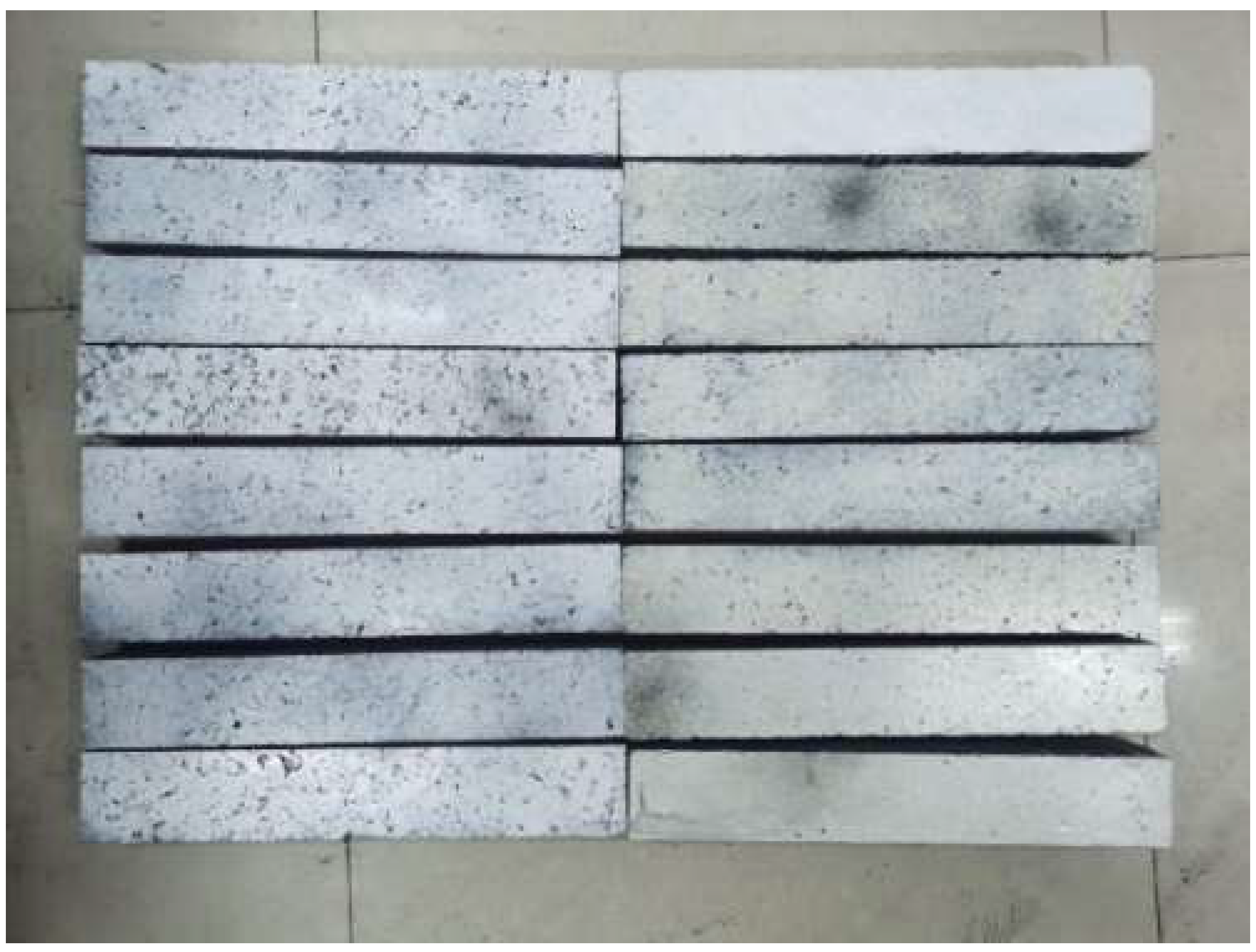
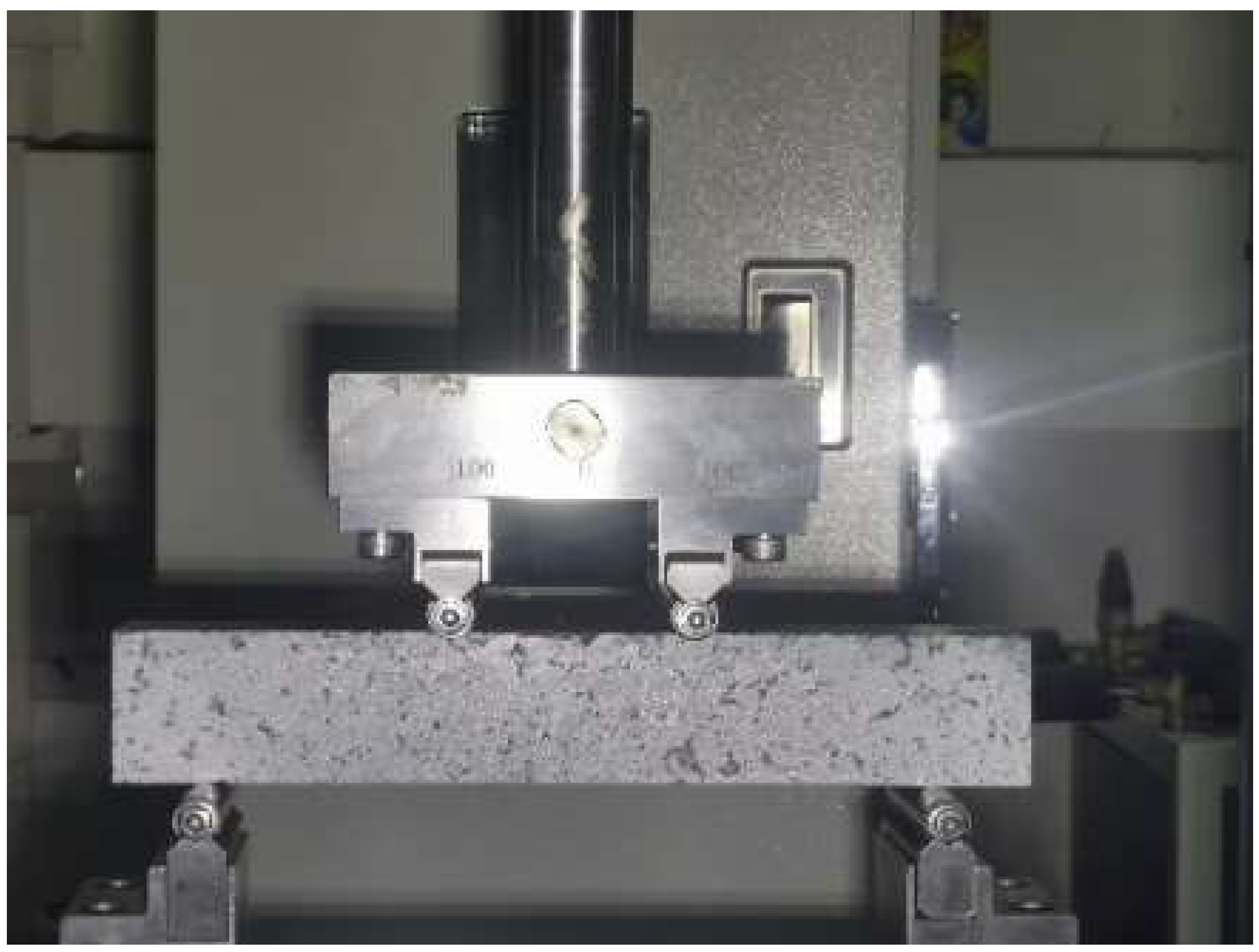
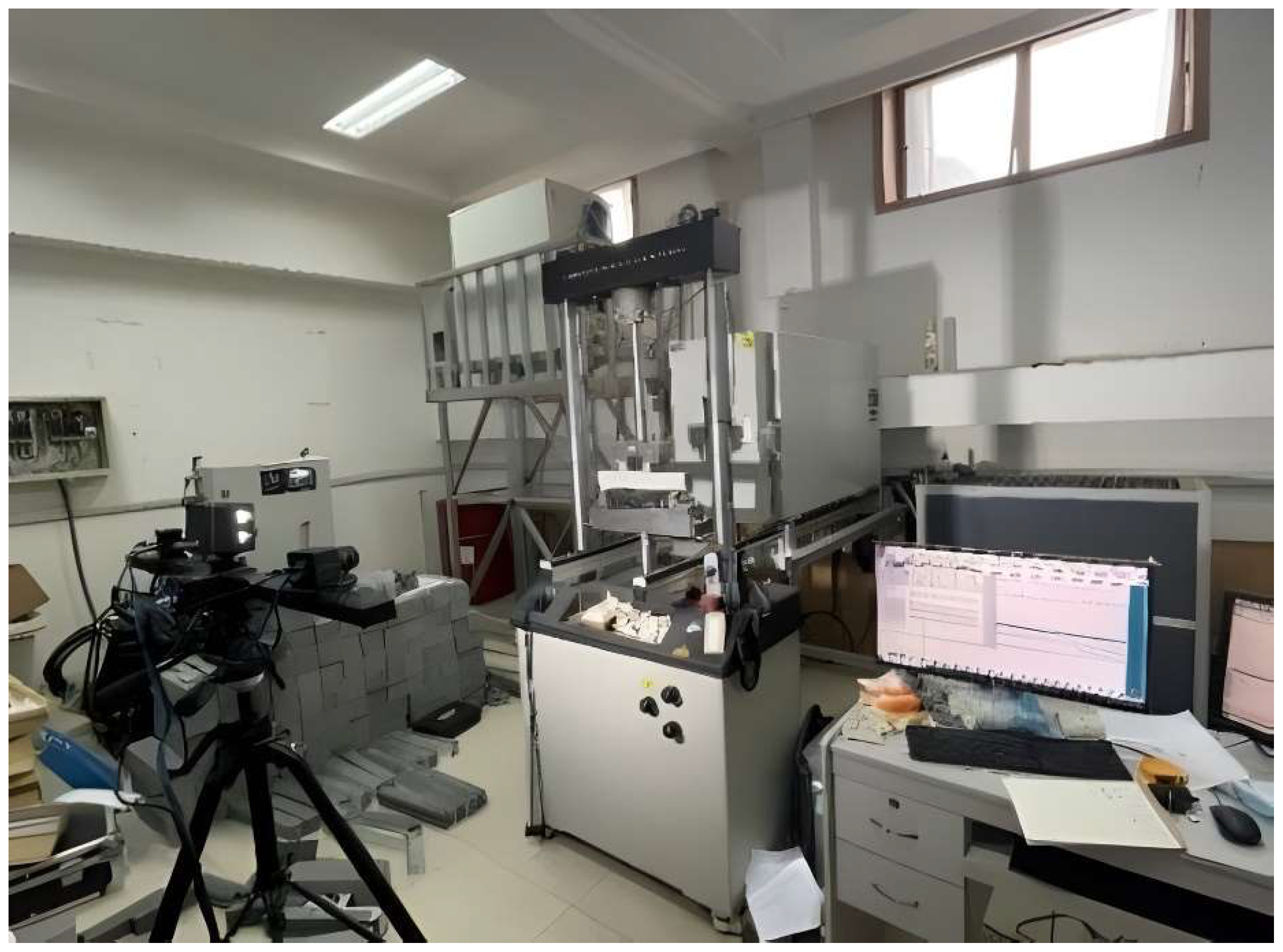

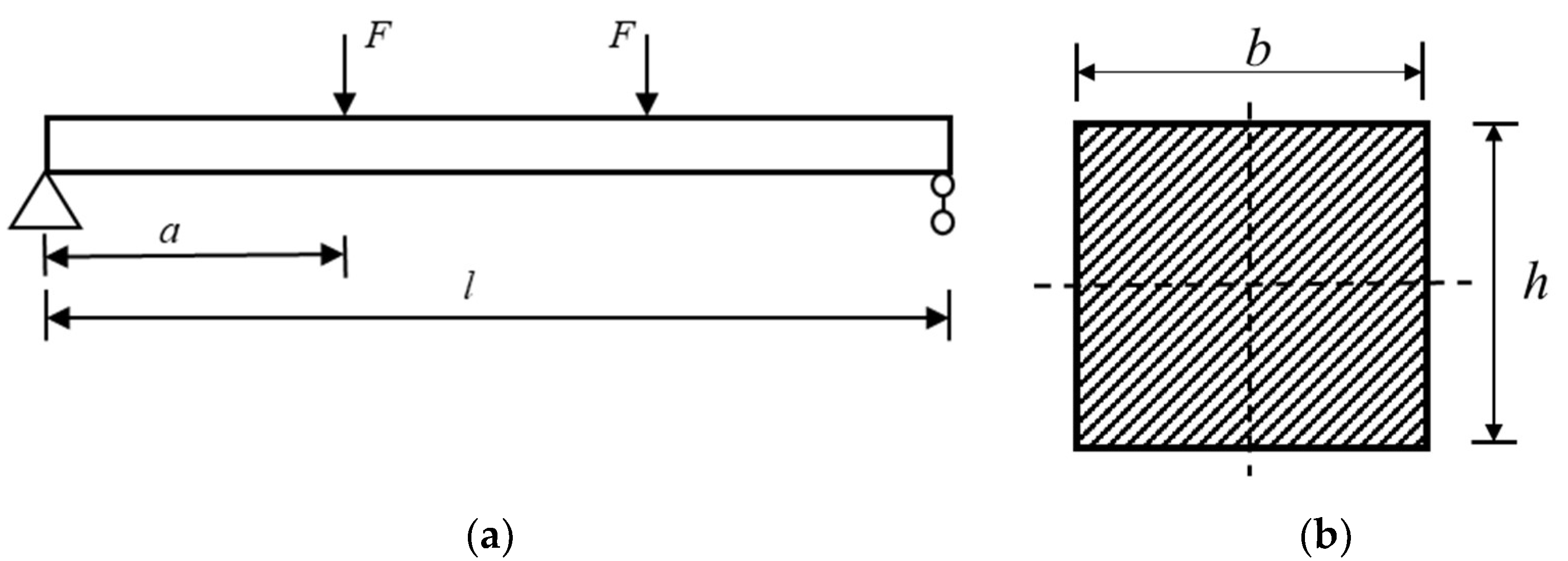

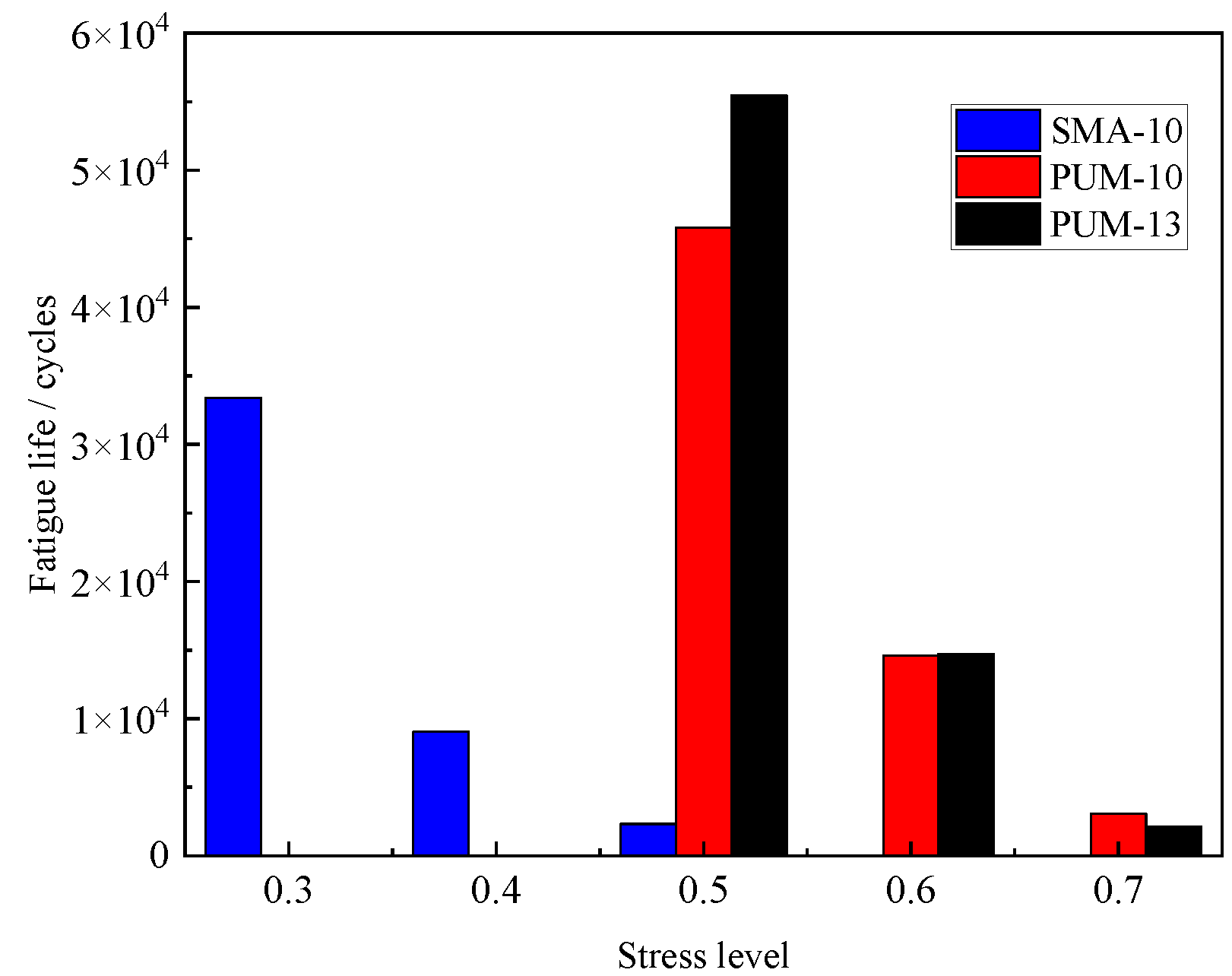
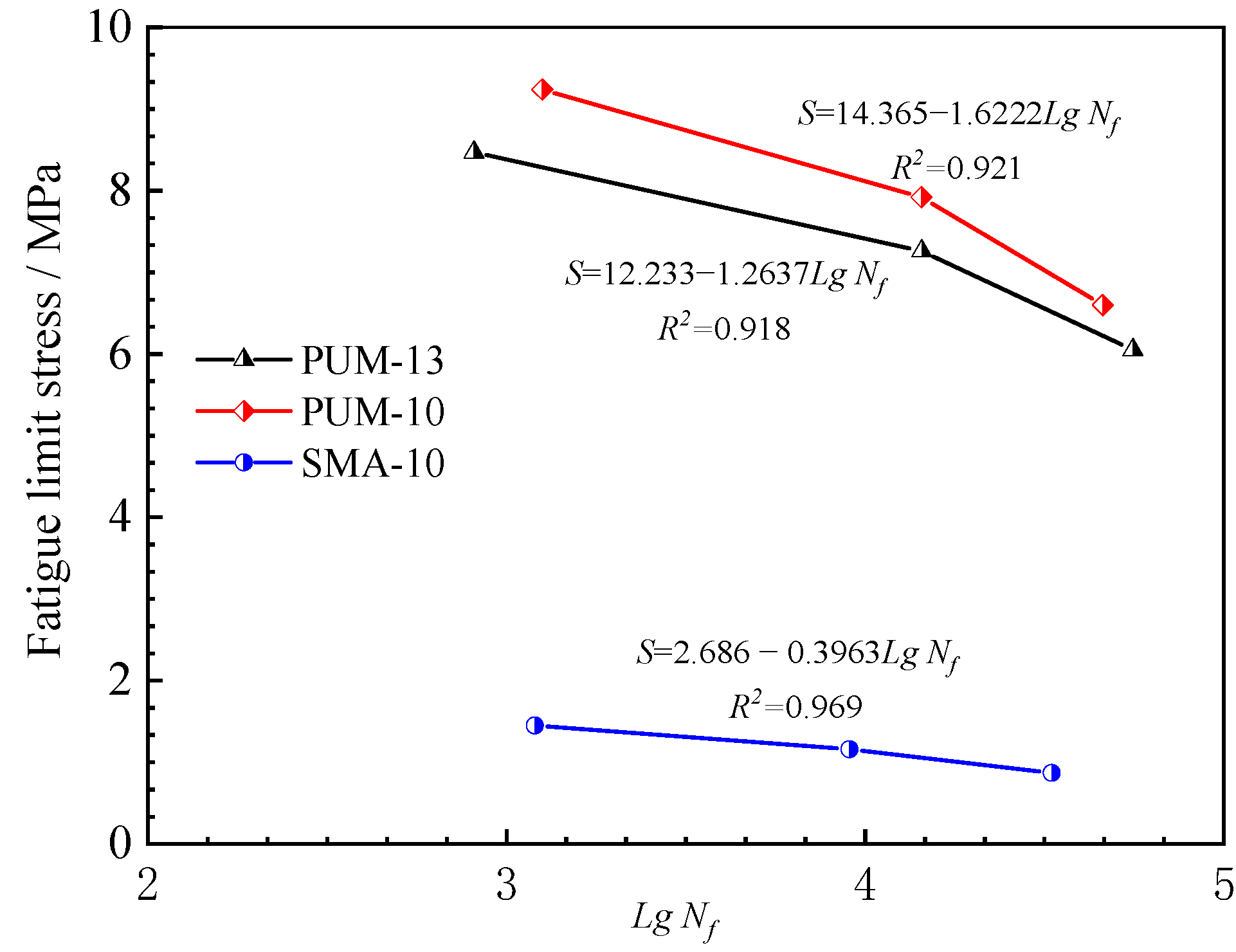
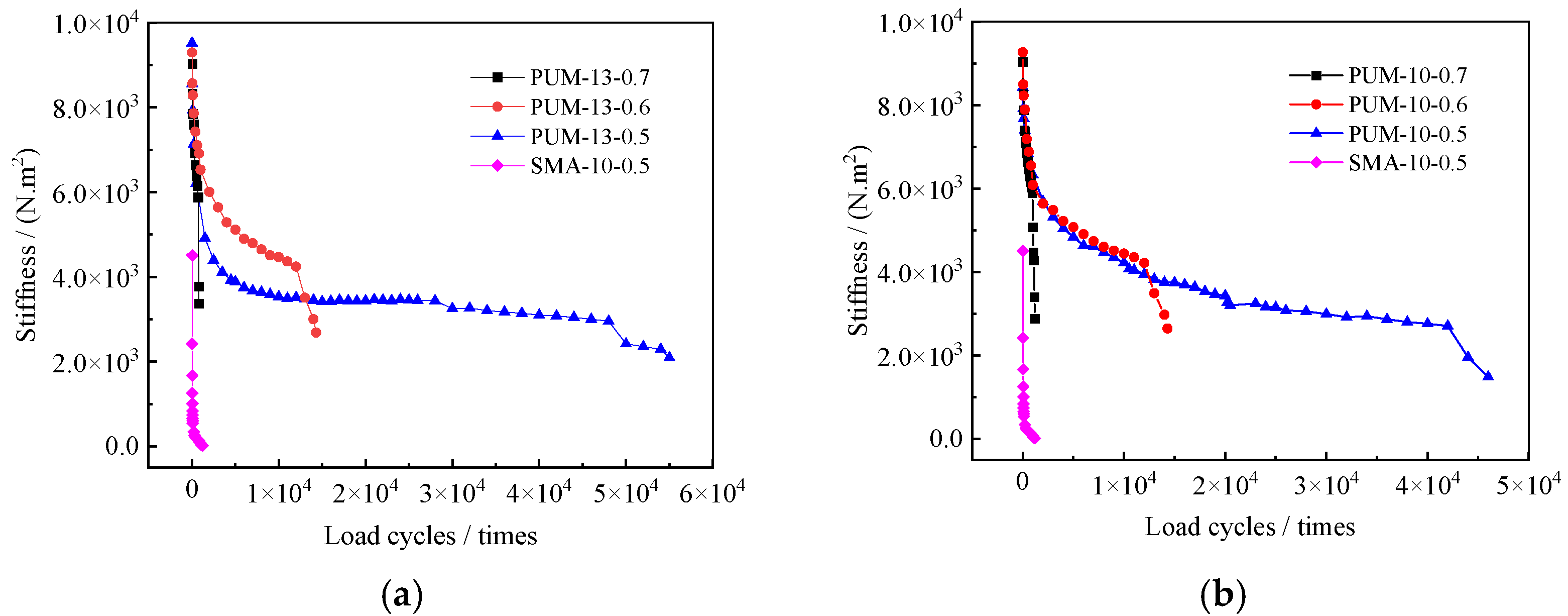
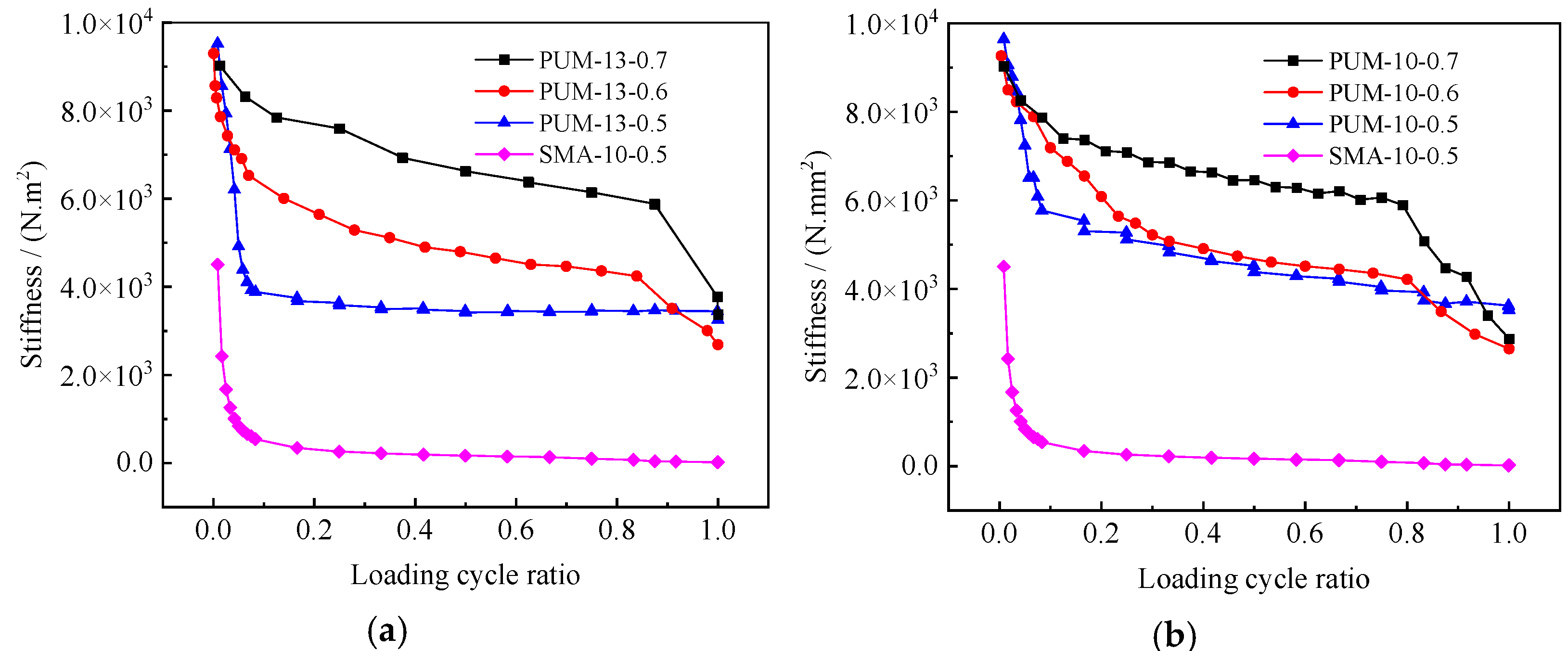
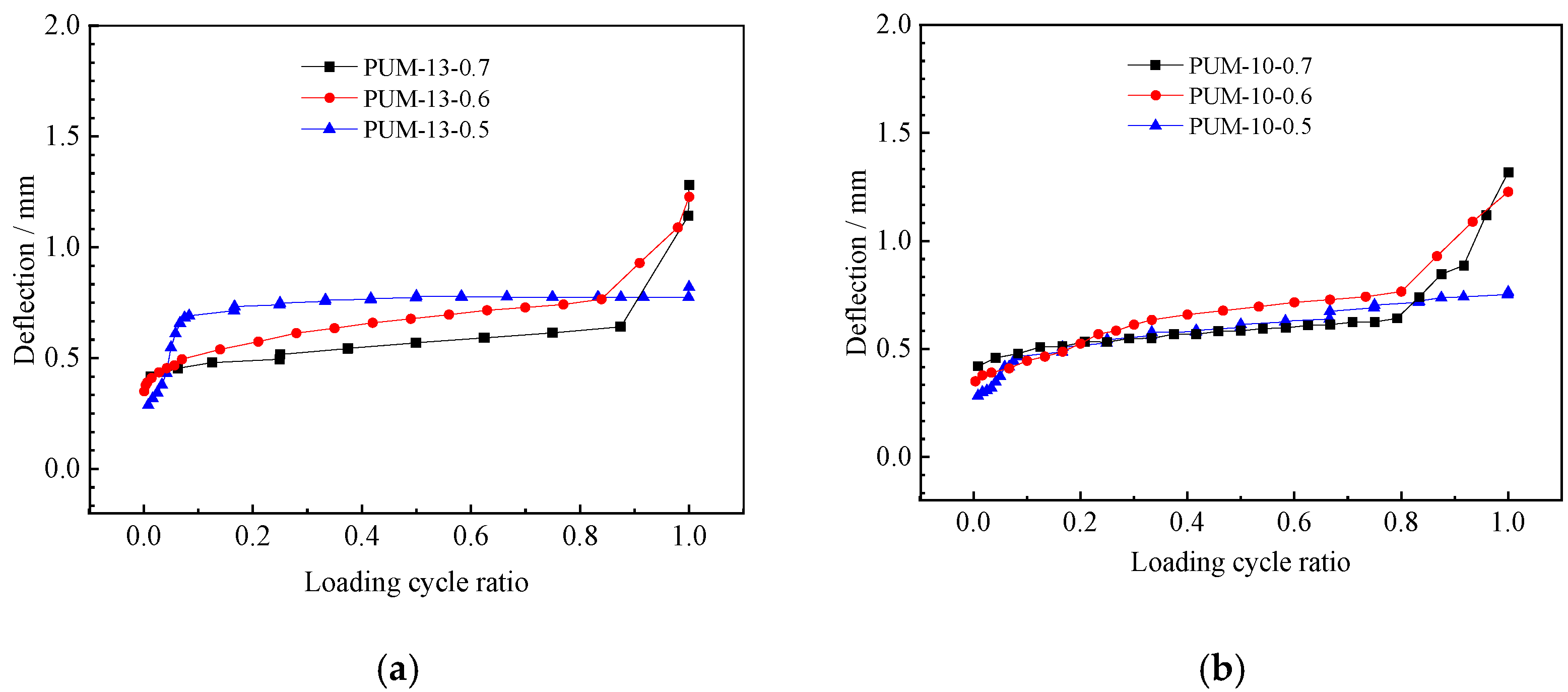
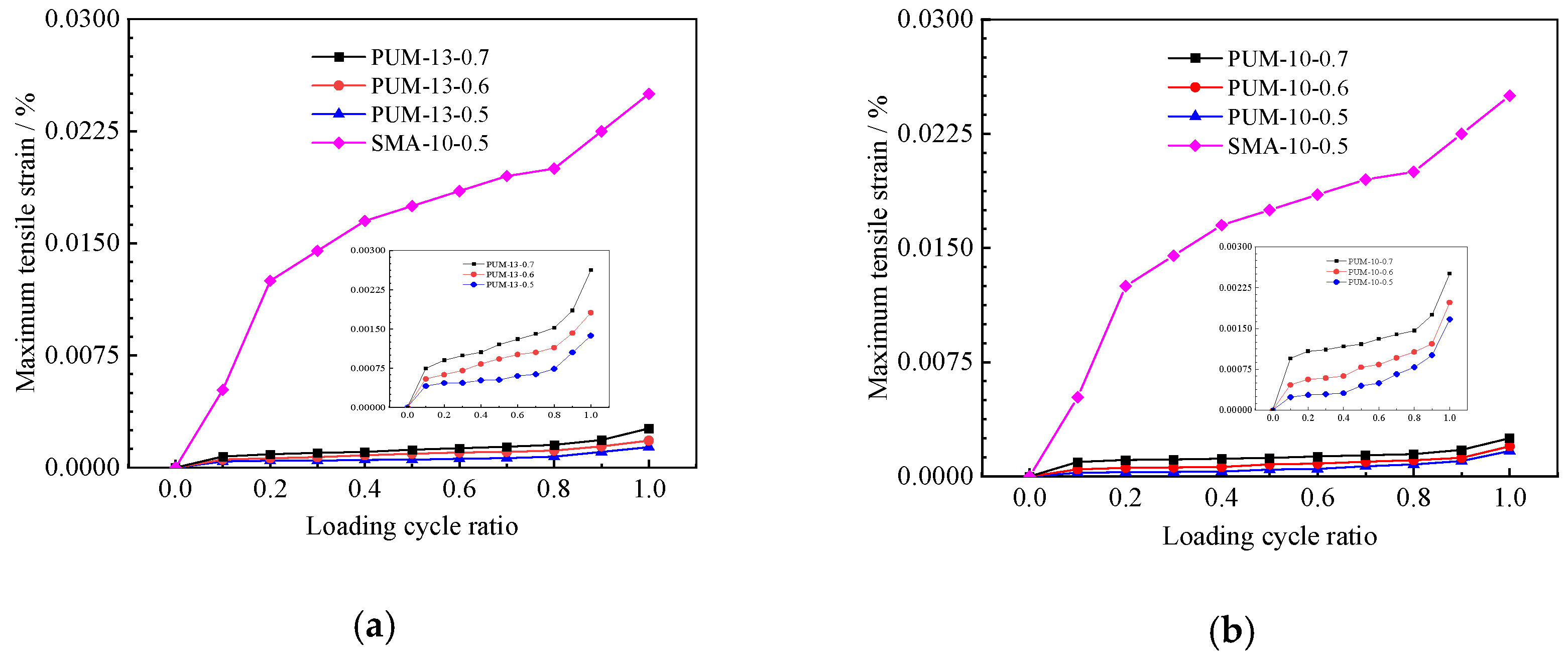


| Technical Indicators | Test Method | Unit | Typical Value |
|---|---|---|---|
| Penetration | T 0604 | 0.1 mm | 53 |
| Penetration Index | T 0604 | / | −0.5 |
| 5 °C Ductility | T 0605 | cm | 48 |
| Softening Point | T 0606 | °C | 86.5 |
| Dynamic Viscosity of 135 °C | T 0625 | Pa.s | 2.16 |
| Technical Indicators | Test Method | Unit | Technical Requirement | Typical Value |
|---|---|---|---|---|
| Appearance | GB/T 13658 | / | Brownish yellow liquid | / |
| Viscosity/25 °C | GB/T 12009.3 | mPa.s | 1200–2200 | 1600 |
| Density/25 °C | GB/T 4472 | g/cm3 | 1.05~1.11 | 1.08 |
| Acidity value | GB/T 12009.5 | / | ≤0.03 | 0.01 |
| Surface dry time/25 °C, 50% Humidity | GB/T 13477.5 | h | 5–10 | 6 |
| Tensile strength/25 °C | GB/T 16777 | MPa | ≥10 | 26 |
| Elongation at break/25 °C | GB/T 16777 | % | ≥100 | 200 |
| Sieve Size (mm) | Cumulative Passing Percentage of Each Sieve (mm)/% | Binder Content/% | |||||||||
|---|---|---|---|---|---|---|---|---|---|---|---|
| 16.0 | 13.2 | 9.5 | 4.75 | 2.36 | 1.18 | 0.6 | 0.3 | 0.15 | 0.075 | ||
| SMA-10 | 100.0 | 100.0 | 98.7 | 43.9 | 25.2 | 21.8 | 18.6 | 16.3 | 14.0 | 12.1 | 7.0 |
| PUM-10 | 100.0 | 100.0 | 98.7 | 43.9 | 25.2 | 21.8 | 18.6 | 16.3 | 14.0 | 12.1 | 6.5 |
| PUM-13 | 100.0 | 95.6 | 66.8 | 31.2 | 21.5 | 16.7 | 11.5 | 8.6 | 6.3 | 2.5 | 6.3 |
| Technical Indicators | Unit | SMA-10 | PUM-10 | PUM-13 |
|---|---|---|---|---|
| Void ratio (VV) | % | 5.3 | 4.5 | 4.8 |
| Voids in the Mineral Aggregate (VMA) | % | 17.4 | 14.5 | 14.8 |
| Marshall Stability (MS) | KN | 56.8 | 54.7 | 55.4 |
| Dynamic stability/60 °C | Times/mm−1 | 9146 | 82540 | 86327 |
| Low temperature bending strain/−10 °C | µε | 3120 | 5734 | 5628 |
| Splitting strength | MPa | 1.38 | 3.05 | 3.21 |
| Test Beam Number | Fatigue Loading Data | Static Load Maximum Force/KN | Loading Frequency/ Hz | ||
|---|---|---|---|---|---|
| Loading Level | Fatigue Lower Limit | Fatigue Ceiling | |||
| SMA-10 | 0.3 | 0.06 | 0.60 | 2 | 10 |
| 0.4 | 0.08 | 0.80 | 2 | 10 | |
| 0.5 | 0.10 | 1.00 | 2 | 10 | |
| PUM-10 | 0.5 | 0.41 | 4.05 | 8.1 | 10 |
| 0.6 | 0.49 | 4.86 | 8.1 | 10 | |
| 0.7 | 0.57 | 5.67 | 8.1 | 10 | |
| PUM-13 | 0.5 | 0.45 | 4.45 | 8.9 | 10 |
| 0.6 | 0.53 | 5.34 | 8.9 | 10 | |
| 0.7 | 0.62 | 6.23 | 8.9 | 10 | |
| Type of Mixture | Static Load Failure Time/s | Maximum Deflection/mm | Bending Failure Stress/MPa |
|---|---|---|---|
| SMA-10 | 44.3 | 20.0 | 2.9 |
| PUM-10 | 2.36 | 1.70 | 13.2 |
| PUM-13 | 1.8 | 1.36 | 12.1 |
| Loading Level | a | b | Fatigue Damage Function | Correlation Coefficient | |
|---|---|---|---|---|---|
| 0.5 | 0.19 | 0.79 | 0.9967 | 0.198 | |
| 0.6 | 0.31 | 0.67 | 0.9832 | 0.287 | |
| 0.7 | 0.59 | 0.76 | 0.9878 | 0.403 |
Publisher’s Note: MDPI stays neutral with regard to jurisdictional claims in published maps and institutional affiliations. |
© 2022 by the authors. Licensee MDPI, Basel, Switzerland. This article is an open access article distributed under the terms and conditions of the Creative Commons Attribution (CC BY) license (https://creativecommons.org/licenses/by/4.0/).
Share and Cite
Sun, M.; Qu, G.; Geng, L.; Hou, D.; Jing, S. Fatigue Properties and Damage Characteristics of Polyurethane Mixtures under a Stress Control Mode. Sustainability 2022, 14, 10966. https://doi.org/10.3390/su141710966
Sun M, Qu G, Geng L, Hou D, Jing S. Fatigue Properties and Damage Characteristics of Polyurethane Mixtures under a Stress Control Mode. Sustainability. 2022; 14(17):10966. https://doi.org/10.3390/su141710966
Chicago/Turabian StyleSun, Min, Guangzhen Qu, Litao Geng, Derui Hou, and Shuo Jing. 2022. "Fatigue Properties and Damage Characteristics of Polyurethane Mixtures under a Stress Control Mode" Sustainability 14, no. 17: 10966. https://doi.org/10.3390/su141710966
APA StyleSun, M., Qu, G., Geng, L., Hou, D., & Jing, S. (2022). Fatigue Properties and Damage Characteristics of Polyurethane Mixtures under a Stress Control Mode. Sustainability, 14(17), 10966. https://doi.org/10.3390/su141710966









